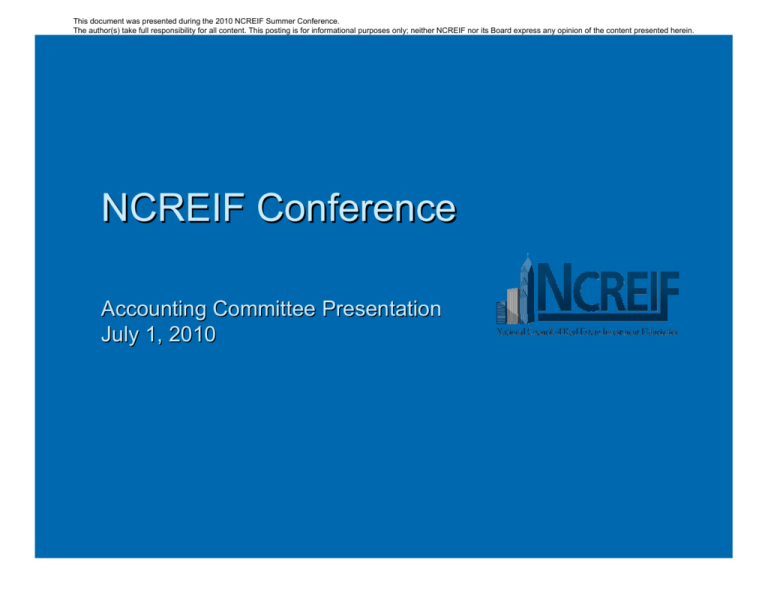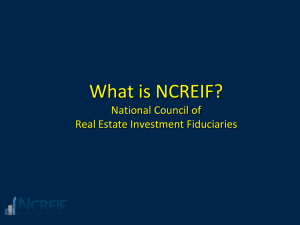Accounting Hot Topics
advertisement

This document was presented during the 2010 NCREIF Summer Conference. The author(s) take full responsibility for all content. This posting is for informational purposes only; neither NCREIF nor its Board express any opinion of the content presented herein. NCREIF Conference Accounting Committee Presentation July 1, 2010 This document was presented during the 2010 NCREIF Summer Conference. The author(s) take full responsibility for all content. This posting is for informational purposes only; neither NCREIF nor its Board express any opinion of the content presented herein. Agenda July 1, 2010 REIS Council Update Technical Update Washington Regulatory Update Market Overview A Consultants Eye View of Due Diligence Sub Committee Time Mezzanine Debt Discussion Hot Topics Subcommittee Time 2 This document was presented during the 2010 NCREIF Summer Conference. The author(s) take full responsibility for all content. This posting is for informational purposes only; neither NCREIF nor its Board express any opinion of the content presented herein. Hot Topics Agenda Credit Line Facility Question Fair Value Measurements Consolidation Models Forward Commitments 3 This document was presented during the 2010 NCREIF Summer Conference. The author(s) take full responsibility for all content. This posting is for informational purposes only; neither NCREIF nor its Board express any opinion of the content presented herein. Hot Topics Credit Line Facility For value-added and opportunistic funds If you have credit facility secured by the commitments of your investors (not by real estate assets), do you include the balance of the credit facility as liability on your balance sheet? Leverage Percentage, which is a recommended item on the REIS checklist, in our quarterly report. One of the calculation methods defined in chapter 4 is Wholly Owned debt (property & fund) + Fund’s Economic Share of JV Debt Total Assets + Fund share of Total JV Liabilities Do you include the balance of the credit facility in the numerator of the Leverage Percentage calculation above? This document was presented during the 2010 NCREIF Summer Conference. The author(s) take full responsibility for all content. This posting is for informational purposes only; neither NCREIF nor its Board express any opinion of the content presented herein. Hot Topics Fair Value Measurements FASB issued ASU 2010-06, which amends ASC 820 (formerly Statement 157) in January 2010. Certain provisions are effective for interim and annual periods beginning after December 15, 2009 This document was presented during the 2010 NCREIF Summer Conference. The author(s) take full responsibility for all content. This posting is for informational purposes only; neither NCREIF nor its Board express any opinion of the content presented herein. Fair Value Measurements Common Issues Transfers between Levels 1, 2, and 3 of the fair value hierarchy. Level of disaggregation of derivative contracts for fair value measurement disclosures. Disclosures about fair value measurement inputs and valuation techniques. This document was presented during the 2010 NCREIF Summer Conference. The author(s) take full responsibility for all content. This posting is for informational purposes only; neither NCREIF nor its Board express any opinion of the content presented herein. Fair Value Measurements Transfer Policy The ASU 2010-06 amendments expand disclosure requirements to include all three levels of the fair value hierarchy. Specifically, a reporting entity is now required to disclose separately the amounts of, and reasons for, significant transfers • Between Level 1 and Level 2 of the fair value hierarchy and • Into and out of Level 3 of the fair value hierarchy for the reconciliation of Level 3 measurements. This document was presented during the 2010 NCREIF Summer Conference. The author(s) take full responsibility for all content. This posting is for informational purposes only; neither NCREIF nor its Board express any opinion of the content presented herein. Fair Value Measurements Transfer Policy A fund/account must disclose and follow a consistent policy for determining when transfers between levels are recognized. The disclosure requirement is based on significance Significance is based on earnings and total assets or total liabilities or changes in fair value compared to total equity This document was presented during the 2010 NCREIF Summer Conference. The author(s) take full responsibility for all content. This posting is for informational purposes only; neither NCREIF nor its Board express any opinion of the content presented herein. Fair Value Measurements Transfer Policy Examples of policies for when to recognize the transfers are as follows: 1. The actual date of the event or change in circumstances that caused the transfer 2. The beginning of the reporting period 3. The end of the reporting period. This document was presented during the 2010 NCREIF Summer Conference. The author(s) take full responsibility for all content. This posting is for informational purposes only; neither NCREIF nor its Board express any opinion of the content presented herein. Fair Value Measurements Definition of Class Are the level of disaggregation for disclosures of class with respect to derivatives under ASC 820 (as amended by ASU 2010-06) the same as that for disclosures under ASC 815 – formerly SFAS No. 133? What does a class mean for real estate? • Equity • Securities • Mezzanine debt This document was presented during the 2010 NCREIF Summer Conference. The author(s) take full responsibility for all content. This posting is for informational purposes only; neither NCREIF nor its Board express any opinion of the content presented herein. Fair Value Measurements Definition of Class ASC 820-10-50-2 states, in part: “The reporting entity shall disclose all of the [fair value disclosure information] in (a) through (e) for each interim and annual period separately for each class of assets and liabilities. The reporting entity shall determine appropriate classes of assets and liabilities on the basis of guidance in the following paragraph. It shall provide sufficient information to permit reconciliation of the fair value measurement disclosures for the various classes of assets and liabilities to the line items in the statement of financial position.” This document was presented during the 2010 NCREIF Summer Conference. The author(s) take full responsibility for all content. This posting is for informational purposes only; neither NCREIF nor its Board express any opinion of the content presented herein. Fair Value Measurements Definition of Class Moreover, ASC 820-10-50-2A provides guidance on determining classes of assets and liabilities, stating, in part: “In determining the appropriate classes for fair value measurement disclosures, the reporting entity shall consider the level of disaggregated information required for specific assets and liabilities under other Topics. For example, under Topic 815, disclosures about derivative instruments are presented separately by type of contract such as interest rate contracts, foreign exchange contracts, equity contracts, commodity contracts, and credit contracts.” This document was presented during the 2010 NCREIF Summer Conference. The author(s) take full responsibility for all content. This posting is for informational purposes only; neither NCREIF nor its Board express any opinion of the content presented herein. Fair Value Measurements Definition of Class Consequently, questions have arisen about how the term “class,” as discussed in ASC 820, compares with the term “type of contract” used for the ASC 815 tabular disclosures. In supporting its judgments about the determination of class for its derivative contracts, a reporting entity should consider the type of derivative contracts it holds (i.e., the level of disaggregation required for the ASC 815 tabular disclosures). However, as described in ASC 82010-50-2A, class is based on the nature and risks of the derivatives and their classification in the hierarchy and is often at a greater level of disaggregation than the reporting entity’s line items in the statement of financial position. This document was presented during the 2010 NCREIF Summer Conference. The author(s) take full responsibility for all content. This posting is for informational purposes only; neither NCREIF nor its Board express any opinion of the content presented herein. Fair Value Measurements Definition of Class Therefore, in determining the nature and risks of its derivative contracts, a reporting entity should consider the following factors (in addition to type of contracts): the valuation techniques and inputs used to determine fair value, the classification in the fair value hierarchy, and the level of disaggregation in the statement of financial position. A reporting entity may also consider the level of disaggregation it uses for other ASC 815 disclosures (e.g., qualitative and volume), which may vary from the level of disaggregation it uses for the ASC 815 tabular disclosures. This document was presented during the 2010 NCREIF Summer Conference. The author(s) take full responsibility for all content. This posting is for informational purposes only; neither NCREIF nor its Board express any opinion of the content presented herein. Fair Value Measurements Definition of Class ASC 320-10-50-1B provides guidance on class determination and provides useful general considerations for assessing nature and risks. Concentrations are likely to be key considerations in the class determination for all assets and liabilities within the scope of the ASU. This document was presented during the 2010 NCREIF Summer Conference. The author(s) take full responsibility for all content. This posting is for informational purposes only; neither NCREIF nor its Board express any opinion of the content presented herein. Fair Value Measurements Definition of Class With respect to derivatives, the classes of derivative contracts under the ASC 820 disclosures may differ from the “type of contracts” used for the ASC 815 tabular disclosures. Depending on the facts and circumstances, class may be more disaggregated than “type of contract” but generally should not be more condensed. This document was presented during the 2010 NCREIF Summer Conference. The author(s) take full responsibility for all content. This posting is for informational purposes only; neither NCREIF nor its Board express any opinion of the content presented herein. Fair Value Measurements Quantitative Information About Inputs Questions have arisen about whether ASC 820 now requires entities to disclose quantitative information about inputs. ASC 820, as amended by ASU 2010-06, requires a reporting entity to provide disclosures about the valuation techniques and inputs used to measure fair value for both recurring and nonrecurring fair value measurements in Level 2 or Level 3 of the fair value hierarchy and for each class of assets and liabilities. This document was presented during the 2010 NCREIF Summer Conference. The author(s) take full responsibility for all content. This posting is for informational purposes only; neither NCREIF nor its Board express any opinion of the content presented herein. Fair Value Measurements Quantitative Information About Inputs ASC 820-10-50-2(e) states that entities must disclose: For fair value measurements using significant other observable inputs (Level 2) and significant unobservable inputs (Level 3), a description of the valuation technique (or multiple valuation techniques) used, such as the market approach, income approach, or the cost approach, and the inputs used in determining the fair values of each class of assets or liabilities. If there has been a change in the valuation technique(s) (for example, changing from a market approach to an income approach or the use of an additional valuation technique), the reporting entity shall disclose that change and the reason for making it. This document was presented during the 2010 NCREIF Summer Conference. The author(s) take full responsibility for all content. This posting is for informational purposes only; neither NCREIF nor its Board express any opinion of the content presented herein. Fair Value Measurements Quantitative Information About Inputs For examples of disclosures that a reporting entity may present to comply with the requirement to disclose the inputs used in measuring fair value in this paragraph, see paragraphs 820-10-5522A through 55-22B. This document was presented during the 2010 NCREIF Summer Conference. The author(s) take full responsibility for all content. This posting is for informational purposes only; neither NCREIF nor its Board express any opinion of the content presented herein. Fair Value Measurements Quantitative Information About Inputs ASC 820-10-55-22A states, in part: Examples of disclosures that the reporting entity may present to comply with the input disclosure requirement of paragraph 820-1050-2(e) include quantitative information about the inputs, for example, for certain debt securities or derivatives, information such as, but not limited to, prepayment rates, rates of estimated credit losses, interest rates (for example, LIBOR swap rate) or discount rates, and volatilities. This document was presented during the 2010 NCREIF Summer Conference. The author(s) take full responsibility for all content. This posting is for informational purposes only; neither NCREIF nor its Board express any opinion of the content presented herein. Fair Value Measurements Quantitative Information About Inputs In preparing its disclosures about inputs, a reporting entity should follow the above-cited guidance from ASC 820-10-50-2(e). There should be some degree of consistency between the items discussed in the narrative about inputs and valuation techniques used and class determination. This document was presented during the 2010 NCREIF Summer Conference. The author(s) take full responsibility for all content. This posting is for informational purposes only; neither NCREIF nor its Board express any opinion of the content presented herein. Consolidation Accounting Under ASC 810-10, there are two primary models for determining whether consolidation is appropriate: the VIE model and the voting interest model. FASB Accounting Standards Update No. 2009-17, Improvements to Financial Reporting by Enterprises Involved With Variable Interest Entities, amends the variable interest entity (VIE) model and is effective as of the beginning of each reporting entity’s first annual reporting period that begins after November 15, 2009, and for interim periods within those reporting periods. This document was presented during the 2010 NCREIF Summer Conference. The author(s) take full responsibility for all content. This posting is for informational purposes only; neither NCREIF nor its Board express any opinion of the content presented herein. Consolidation Accounting FASB Accounting Standards Update No. 2010-10, Amendments for Certain Investment Funds, indefinitely defers the amendments in ASU 2009-17 for a reporting entity’s interest in certain entities and amends the guidance in ASC 810-10-55-37 (as amended by ASU 2009-17) on determining whether a decision-maker or serviceprovider fee represents a variable interest. The deferral will be most applicable to interests in certain investment funds such as: • Investment Companies • Funds for which it is industry practice to apply measurement principles for financial reporting purposes that are consistent with those followed by investment companies Are any GASB 25 or FASB 35 funds deferring application? This document was presented during the 2010 NCREIF Summer Conference. The author(s) take full responsibility for all content. This posting is for informational purposes only; neither NCREIF nor its Board express any opinion of the content presented herein. Consolidation Accounting For reporting entities that meet the deferral conditions, the guidance on VIEs in ASC 810-10 (before the amendments in ASU 2009-17 and the amendments to ASC 810-10-55-37 in ASU 2010-10) would be used to determine whether the legal entity is a VIE, whether the reporting entity has a variable interest in a VIE, and whether the reporting entity is the primary beneficiary of a VIE. All reporting entities must provide the disclosures in ASC 810-10, as amended by ASU 2009-17, for all VIEs in which they hold a variable interest or for which they are the primary beneficiary — regardless of whether the entity qualifies for the deferral. This document was presented during the 2010 NCREIF Summer Conference. The author(s) take full responsibility for all content. This posting is for informational purposes only; neither NCREIF nor its Board express any opinion of the content presented herein. Consolidation Accounting How should a reporting entity determine which consolidation model is appropriate under ASC 810-10? This document was presented during the 2010 NCREIF Summer Conference. The author(s) take full responsibility for all content. This posting is for informational purposes only; neither NCREIF nor its Board express any opinion of the content presented herein. The Consolidation Model ASC 810 FIN 46 R Variable interest scope exceptions apply? Yes Voting interest model No Do I hold a variable interest in a potential VIE? (before 2009-17) No Yes Qualify for deferral under 2009-7? No Do I have a variable interest in a potential VIE? No (under 2009-17) Yes Is the entity a VIE? (before 2009-17) Yes Yes No No Voting interest model Is the entity a VIE? (under 2009-17) Yes Am I the primary beneficiary? (under 2009-17) Am I the primary beneficiary? (before 2009-17) Either way Apply the disclosure requirements for all VIEs in which the reporting entity holds a variable interest, regardless as to whether the deferral conditions are met This document was presented during the 2010 NCREIF Summer Conference. The author(s) take full responsibility for all content. This posting is for informational purposes only; neither NCREIF nor its Board express any opinion of the content presented herein. Hot Topics Forward Commitments Update from Maria Almounir, Prudential








